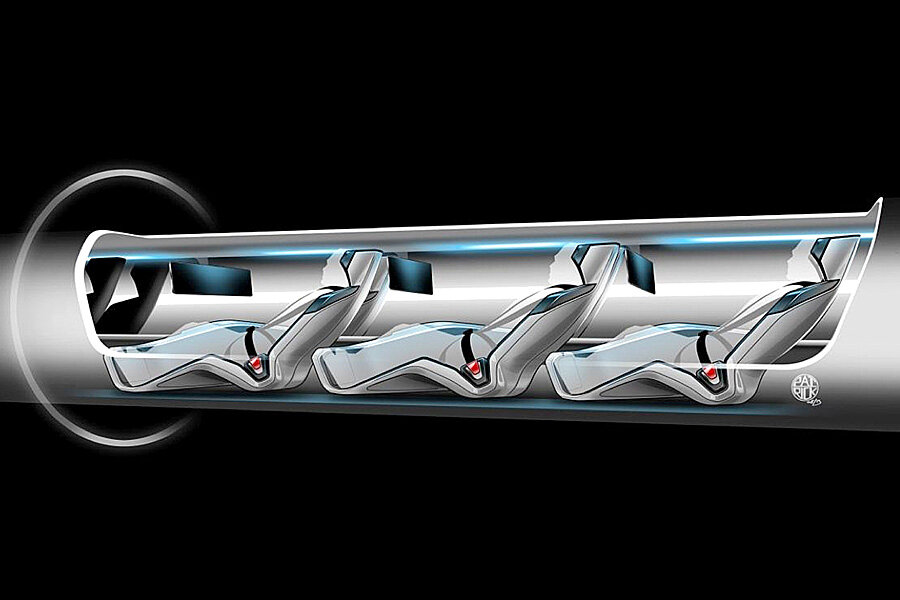Who will make Elon Musk's 'Hyperloop' a reality?
Loading...
The year 1698 brought the first commercially available steam engine; 1908, the first affordable automobile; and 2016, the Hyperloop. Or at least that’s what two California companies and Elon Musk are hoping.
“Elon Musk first introduced his idea for the Hyperloop in August 2013. His design called for aluminum pods that could hold people or cars that would be fired through tubes pulled by electromagnetic force,” reported The Christian Science Monitor earlier this year. “Low pressure compartments and compressor fans would lessen friction, allowing pods to travel at up to 800 m.p.h. – meaning you could travel from Los Angeles to San Francisco in 30 minutes.”
At the time of the announcement, Musk said he would probably build a prototype, remarking “If it was my top priority, I could probably get it done in one or two years."
Unfortunately, Mr. Musk was busy as CEO of both Tesla and SpaceX, unable to devote time to developing the idea, and instead publicly released his initial 57-page plan, urging those interested to make the dream a reality.
A pair of companies took him on, with confusingly similar names – Hyperloop Technologies and Hyperloop Transportation Technologies.
Started via crowdsourcing on JumpStartFund, Hyperloop Transportation Technologies offers stock options for anyone willing to work a minimum of 10 hours a week. The company’s website boasts an ambitious case for the Hyperloop, but fails to shed any light on testing progress, instead just outlining the idea.
Furthermore, the latest post on their site is from February, so it’s unclear what the company has been doing the past six months. But The Verge reports the company has “already begun building models for possible Hyperloop pods, although they have yet to produce a working prototype.”
While the progress and credibility of Hyperloop Transportation Technologies is questionable, Hyperloop Technologies seems to be doing some real work.
With an $80 million investment round in progress, Hyperloop Technologies announced Wednesday that it now has a CEO.
Rob Lloyd, former CEO of Cisco, will be leading some fifty employees, including former Google, Facebook, and Snapchat executive Emily White and former White House deputy chief of staff Jim Messina. With no lack of talent, the team will work on constructing a two-mile long track, which the company says could be complete in 2016 or early 2017 if the investment round closes successfully.
The company’s overall goal is to develop a route from Los Angeles to Las Vegas, with sections going underwater. This is even more outlandish than Musk’s original idea, but the company has already “met with Senate Minority Leader Harry Reid (D) of Nevada and Las Vegas investor Anthony Marnell in an effort to find a way around the right of way laws for high-speed rails between Las Vegas and Nevada.”
Hyperloop Tech, operating out of a Los Angeles “innovation campus,” has already made progress developing and testing compressor technology, building a levitation test rig, and designing the tube architecture.
“The Hyperloop vision is compelling and disruptive. Developing the most transformative new mode of transportation that the world has seen in decades will have a profound impact on people, on economies and on how we all live in the future,” wrote Mr. Lloyd on the company blog.
Hyperloop Technologies “currently looks to be the best chance outside of Elon Musk himself to bring the idea of the Hyperloop closer to reality,” The Verge’s Micah Singleton remarks.
But skeptics argue that the most important questions, such as speed and cost, will not be answered with such a short track.
“As long as the tests are focused on small-scale loops, it's not clear we'll ever get answers to them,” says Russell Brandom. “That's not to say the Hyperloop will turn into a boondoggle, or that the latest round of testing won't be successful. It really is a promising idea, and more research is always a good thing — but the road to a fully functional Hyperloop isn’t getting any shorter.”
And yes, it is still early. Big questions, as well as engineering and logistical challenges remain unsolved. “Yet it’s equally hard to overstate how dramatically the hyperloop could change the world,” says Bruce Upbin, Forbes technology reporter.
As Hyperloop Tech’s website boldly declares, “Hyperloop is real.”





